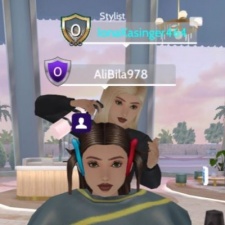Filipe Duarte Pina is a producer at Lockwood Publishing.
Have you ever wondered how long it takes to get a digital haircut? We hadn’t either, that was, until we built our first in-game hairdressers.
Flare Salon is our brand new digital hair salon, set within the virtual world of Avakin Life.
Just like in real-life, you can browse the catalogue for styles, talk and hang out with your friends, check out the latest and trendy new haircuts and also get yourself a (digital) haircut.
And if you need some Avacoins (Avakin Life’s currency), you can roll up your digital sleeves and get a job at cutting other players’ hair.
Oh! And because this is a digital world, “cutting hair” is all a bit relative. Short blonde curls can transform into long purple locks and a bald man can come out of the salon sporting a fancy bob. Classic video game mechanics.
But how exactly do you drive the economy of a hair salon in a Game-as-a-Service (GaaS) title and let players have fun without getting in the way too much?
We didn’t know either, until we tried.
Collaboration, not competition
One of the mantras we use when developing new mini-games inside Avakin Life is that the experience is all about connecting players; how can we make them work and play together instead of competing?
It might sound obvious but as we all know, in the videogame design business it is all too easy to fall into the competitive mechanics of old - leaderboards, daily and weekly objectives, highest scores and so on.
So, early on, the social engagement that our core users love so much, made us pitch a bunch of mini-games ideas internally.
One that really stuck was creating a hairdressers or, as we eventually came to call it, the Flare Salon.
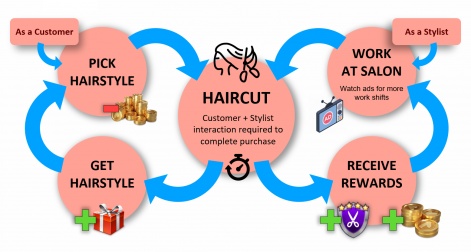
The Flare Salon brought together all the important game principles that define our initiatives. Among many others, it has “Clarity of Purpose” - it is easy to understand what you can do at a hairdressers.
It is “Social First” - it’s a social thing that brings people together instead of pushing them apart.
A huge percentage of the population that likes getting a haircut because it allows for some deep relaxing.
It is “Foundational” - from this simple premise, we can expand for other types of similar jobs inside Avakin Life using the exact same mechanics and it can also expand itself.
And many more principles including “Supports Events”, “Operationally Robust”, “Skinnable”, provides “Sharing Moment” and, obviously “Monetises”.
So, how much time does it take to cut a digital hair?
From early research it was clear Flare Salon was a winner on all fronts but right from the first design drafts one question started popping up that would haunt us all the way through QA: How much time does it take to cut a digital hair?
Well, technically it takes milliseconds.
We can change the hair on a character almost instantly from the moment it is bought.
And because “cutting hair” in Avakin Life is simply swapping 3D hair pieces (or not, in case the player wants to get bald), the question became more one of introspection and genuine video game design for the entire team. Even Halli, our CEO, pitched in on ‘how long should a digital haircut take?’.
The first prototype had a haircut taking 25 seconds from start to finish.
From a monetisation and design point of view it sounded reasonable enough. Not too short, not too long.
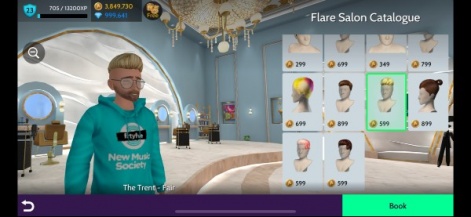
The Customer wants their haircut as fast as possible and the Stylist wants to earn their Avacoins.
But we didn’t want it to feel like there was no work involved, so besides taking 25 seconds, we put in some animations of the hair being cut, some nice camera angles, some cool visuals and sound effects and voilá! It looked great!
25 seconds was way too fast. Should it be longer? How much longer?
But it still felt like 25 seconds was way too fast. Should it be longer? How much longer? In real-life it can take anything from 30 minutes to 2 hours.
But we didn’t want that in our game, players would lose their minds waiting and would never buy a haircut ever again. So how much longer should it be? And would that ruin the experience?
We decided to delve deeper.
What exactly do you do when you are getting a haircut in real life?
Well, it seems that regardless of age, sex, social status and religious beliefs and not counting with the small percentage that tries really hard not to fall asleep, there is a huge percentage of the population that likes getting a haircut because it allows for some deep relaxing and engaging therapeutical conversation.
Some would even say that getting a haircut is the cheap version of going to the psychologist.
So, why not reinforce this in our digital world?
Alongside the core business loop of The Customer and The Stylist, a new interesting possibility emerged: the possibility of a semi-forced private and exclusive interaction of two players who are waiting for a business transaction to conclude.
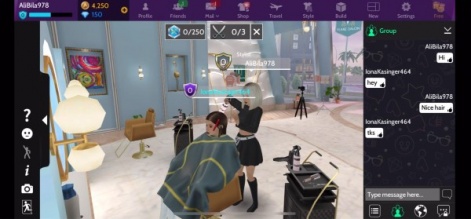
AKA: because I have to wait to get my new haircut and because they have to wait to get paid for cutting my hair, why not engage in a friendly conversation? Just like in real-life!
- Stylist - So, err… did you watch the game last night?
- Customer - The Reds vs the Blues? Yeah!
- Stylist - Amazing game, yada, yada, yada.
- Customer - Indeed, and the match was yada, yada, yada.
Considering this we decided to open up a private chat between the two players whenever a haircut starts. No other player can see this chat and they cannot join them.
With this move Flare Salon became something more.
It was not just a place to cut your digital hair or make some Avacoins, it became a place to socially engage with players that you would normally not talk with.
Design challenges
Just like with any GaaS title, designing and creating something for an ever-changing virtual world can be tricky. You have to look at everything. And I mean EVERYTHING.
On the monetisation side, it has to work with the economy, not against it. Premium players, who regularly purchase IAPs and Avacoins packs, cannot view it as an unfair method of earning currency.
And because players can already work jobs for Avacoins, it needs to feel like an extension of this reality and a new experience.
On the physical 3D space we have to account for players who use all manners of items like wings and backpacks, or players who like to make good usage of “goofy” animation sets, like hovering or crawling around.
We took care of this by making the space wide and ample, with enough room in between the chairs for cutting hair as well as a lot of space for legs.
And when the player sits in their chair, we turn off all extra accessories to avoid polygonal clipping of assets and maintain realism.
We also needed to consider the amount of players that can exist on any space at any point in time. The amount of chairs, the size of the space and even the bright and colourful color scheme helps the flow of players around the Flare Salon.
A very neat thing with Avakin Life mini-games is that they are server-based, so updating them and adding more doesn't require updates to the base client.
"Personalising your Avakin is often a solo experience, so one of our main design goals with the Flare Salon was to offer a fun roleplaying space where players could share their transformation with others," comments game designer Carlos Leituga.
"And who knows, maybe one day we'll have other aspects of customization that will receive the same treatment."
Finally, to make everything more grounded and real, we created a new NPC called Gustav.
Gustav is the owner of the Flare Salon. He also serves as the guide for newcomers and experienced players alike. In a game where millions of Avakins create their own adventures each week, our NPCs are a safe anchor for them to engage with. It also creates familiarity as we evolve the NPC, adding more lines and possible conversations.
All in all, it can take a good 2 to 3 months with a UX team to go through all possibilities and solutions before we settle on the first draft of the players’ flow.
"We wanted the UX to feel as fluid and unobtrusive as possible to allow players to fully engage with the environment and invest in the role play and social experience," says senior UX designer Jen Marshall.
"This was occasionally tricky as we had to work with existing technology and UI patterns. Keeping players in-scene whilst browsing the catalogue and choosing their style was a big win for us as it helped to maintain that engagement between player and scene. ❞
Head of fashion Jade How adds "Our goal here was to create the Hairdressers Outfit, we wanted it to be obvious as a uniform but still retain some fun and stylish avakin desirables within them.
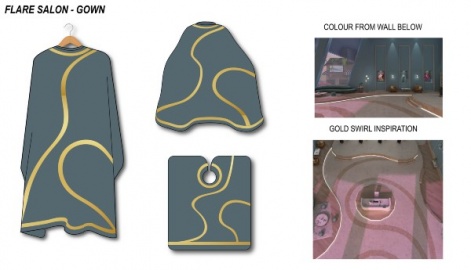
"We opted for black as this is a traditional uniform colour and it keeps the focus on all the other amazing styles that the customer/user would be wearing. The gown was designed with the environment in mind and reflects the interior finish with its colour and print application."
Technical challenges
Avakin Life runs on thousands of mobile devices. As of writing, we support all the way back to Android 5 and iOS 11, running on what are already considered “old phones”.
It helps make Avakin Life an inclusive experience for players around the globe, no matter their budget.
For the Flare Salon it meant making sure that we had to start Performance QA as soon as we could.
The final 3D space occupies close to 20 megabytes and can hold 4 working players on 4 chairs, with one NPC (Gustav) plus another 10 players either queuing to get a haircut or waiting for a free chair to start their shift.
The Flare Salon is the first of many new, advanced mini-games that will start appearing in Avakin Life.
All this works flawlessly in tandem with our existing menus, animations, in-game pop-ups, etc.
"Implementing a mini-game inside Avakin Life has many similarities with working on a regular videogame. We began with a quick prototype to show that the core works, then we added some visual flair to showcase to the different teams inside Lockwood," says lead developer Daniel Policarpo.
"As we developed the mini-game, we continuously refined the experience and polished the code. As we started getting feature creep we prayed to the design gods and goddesses for us to stop putting in new features. Eventually we reached that last 10% that always takes forever to finish.
"A very neat thing with Avakin Life mini-games is that they are server-based, so updating them and adding more doesn't require updates to the base client, unless we are dealing with new features that it doesn't currently support."
Junior Unity developer Ivo Penedo adds "It was technically challenging to adapt the 23rd Street Café mini-game into the Flare Salon mini-game, because the two experiences are so different, having to turn a one-at-a-time job to multiple people working at the same time was not a piece of cake.
"Much like an actual salon, the Flare Salon was thought to be a very social experience, and to achieve that we added some elements to create a bond between stylist and customer, not only the previously mentioned private conversation during the haircut interaction, but also some UI improvements that will help strengthen that connection."
Conclusion
When I told my friends that I was building a digital hair salon they couldn't figure out if I was joking or talking seriously.
But the idea of transporting real-life experiences into video games is as old as video games themselves, and it works as well as it did back when Activision Decathlon was first shown.
It will continue to do so as long as these experiences are well thought out and take into account your audience. The Flare Salon is the first of many new, advanced mini-games that will start appearing in Avakin Life.
More will come and with our game and our tech constantly evolving, each will be more interesting and more engaging than the last.
So... how much time does a digital haircut take? Around 60 seconds.

